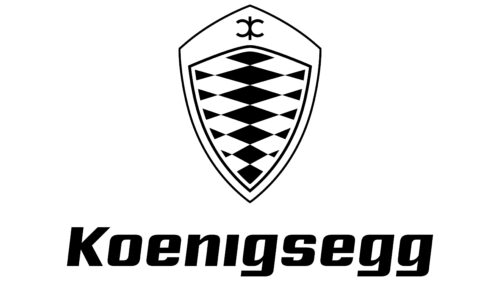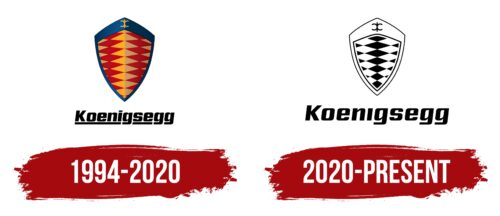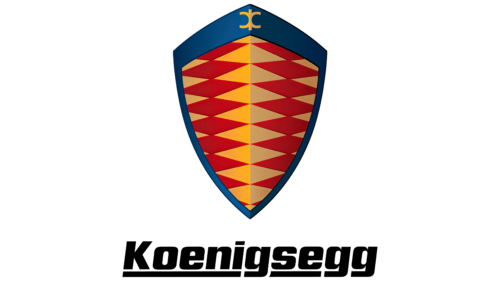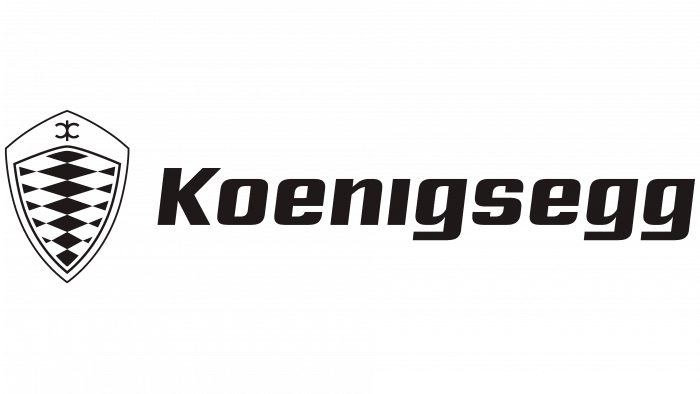The Koenigsegg logo represents the elite of sports cars. The emblem’s coat of arms style indicates the manufacturer’s honor and dignity. It also indicates the quality of cars and the details that make a sports car a respected adversary on the track.
Koenigsegg: Brand overview
The Swedish sports car manufacturer Koenigsegg entered the market in 1994. He became a dream come true for Christian von Koenigsegg, who fell in love with the automotive industry at six when he first saw The Pinchcliffe Grand Prix. The budding inventor wanted to create his racing car, just like the protagonist of the TV show. And he succeeded: the Koenigsegg project was more than successful and eventually grew into a large-scale, world-class business.
The company produces hypercars that are striking in technical excellence. One of the latest models is the high-performance Gemera, designed for four people. It is not inferior to standard two-seater supercars and can speed up to 248 mph.
Meaning and History
Although the Koenigsegg emblem does not reflect the history of victories, it is a direct path to them. The company settled on a heraldic style to show that its cars are fit to participate in “jousting tournaments.” They are suitable for harsh operating conditions and competitions, from which they are ready to emerge with royal honor. Therefore, the identity of the manufacturer of elite sports cars is associated with the coat of arms, reminiscent of the times of noble warriors.
What is Koenigsegg?
It is a powerful sports car manufacturer from Sweden. He develops all the components and subsystems for cars, not trusting other companies.
1994 – 2020
Koenigsegg cars are distinguished by their capabilities and the traditional logo – a coat of arms with a red and yellow diamond pattern and a blue frame. In the upper part, there is an abstract figure in the Cyrillic letter “Ж”: two semi-rings separated by a vertical line.
This drawing was taken from the real family coat of arms, which once belonged to Christian von Koenigsegg’s ancestors. The company owner delved into his family’s history and discovered that its roots go back to the 12th century, in the era of the knights. So, the car brand reflects, to some extent, the legacy of the old days.
Small details have been changed in the logo, such as the golden badge at the top. It did not appear by chance and is used not only as a decoration. This is an unusual monogram made up of the letters KCC. The abbreviation is derived from the full name of the car manufacturer: Koenigsegg CC.
Of course, the brand’s creator was not involved in graphic design himself. He assigned this task to a specialist—his high school friend Jacob Laftman. A talented artist immediately got down to business, so in 1994, the project already had an identity system. The logo looks progressive, but it has an imprint of a long tradition. It reflects the company’s concept based on modern technology and age-old values. In addition, Koenigsegg has a wordmark: black italic lettering with an underscore.
2020 – today
Automaker Koenigsegg has adopted a monochrome logo to focus on details. By this, she wants to demonstrate high-quality products with accurate and perfect elements. In addition, the emblem emphasizes that a large and flawless object is formed from many well-fitted and correctly arranged small parts. All yellow rhombuses in it are repainted in black, and red rhombuses are repainted in white. The KCC monogram is kept at the top. Only the name of the manufacturer has changed. The underline in the inscription has disappeared, and the inscription itself has become large.
Koenigsegg: Interesting Facts
Koenigsegg Automotive AB, founded by Christian von Koenigsegg in 1994, is a marvel in the hypercar industry, celebrated for its pioneering spirit in innovation, performance, and luxury. Nestled in Ängelholm, Sweden, this company has left an indelible mark on the hypercar scene with its avant-garde designs and engineering breakthroughs.
- From Vision to Reality: The spark for Koenigsegg ignited at age five for Christian von Koenigsegg after watching “Flåklypa Grand Prix.” This early dream to craft a supreme sports car drove him from childhood fantasies to real-world achievements.
- Debuting with Distinction: The CC8S, unveiled in 2002 as Koenigsegg’s inaugural production model, set a new precedent for the brand’s commitment to outstanding performance and ingenuity, clinching a Guinness World Record for its powerhouse engine.
- Speed Kings: Koenigsegg vehicles are synonymous with shattering speed records, notably the Agera RS, crowned the fastest production car globally in 2017, boasting a top speed of 277.9 mph (447.2 km/h).
- Engineering Excellence: Regera’s Direct Drive System is among its many innovations, eschewing conventional transmissions. This masterpiece accelerates from 0 to 249 mph (0 to 400 km/h) in under 20 seconds, demonstrating unparalleled efficiency and force.
- Exclusivity in Craft: Koenigsegg’s dedication to exclusivity is evident in its limited production runs. Handcrafting each car ensures every piece is a collector’s gem, and yearly outputs are deliberately kept scarce.
- Eco-Innovations: Koenigsegg is speed and luxury; it also ventures into eco-friendly innovations, exploring biofuels and hybrid technologies to marry sustainability with high performance.
- Ghost Squadron Heritage: The brand’s home in Ängelholm, on a former Swedish Air Force base, draws its “Ghost Squadron” moniker from the site’s historical squadron, inspiring the company’s test drivers and aficionado circle.
- Design as Art: Koenigsegg cars are as visually captivating as they are technologically advanced, mirroring Christian von Koenigsegg’s zeal for design that marries aesthetics with function in every model.
- The Jesko Tribute: Named in honor of Christian’s father, the Jesko is designed to dominate the track while remaining street-legal. It features a groundbreaking 9-speed transmission and boasts potential speeds over 300 mph.
- Innovating with Gemera: The Gemera breaks new ground as the world’s first “Mega-GT,” a family-friendly four-seater powered by a 1700 hp hybrid engine that doesn’t compromise hypercar performance.
Koenigsegg’s journey is a testament to the relentless pursuit of automotive excellence, innovation, and design. Each vehicle encapsulates the company’s drive to redefine the frontiers of engineering.
Font and Colors
Many car brands use heraldic shields for visual identification. But for Koenigsegg, this symbol has a special meaning because it once belonged to the company’s founder’s ancestors. At the same time, the traditional crest has a modern aesthetic: a three-dimensional pattern of multicolored rhombuses and a stylish monogram of the letters KCC. The full brand name is not included on the shield. Christian von Koenigsegg and Jacob Laftman hoped the emblem would be recognizable enough to be associated with only one automaker.
The inscription is out of the picture. The authors used Neographik Italic for the word “Koenigsegg” in bold italics. All letters (except the first) are lowercase, and almost all (except for the three “g”) are underlined with a long horizontal line. This typography makes the plain black text stand out against a brightly colored billboard.
The emblem’s palette can be called variegated because it combines a variety of colors. The rhombuses are red, yellow, and orange, and the frame has a blue gradient. The designer chose a bold combination to make the Koenigsegg logo stand out from other car companies’ black, white, gray, and silver badges.
FAQ
Which country has Koenigsegg?
The brand is in Ängelholm, Sweden, on a former Swedish Air Force base. Sweden is a fitting home for a company known for its innovative and powerful cars. Here, the company designs and produces cars renowned for speed and luxury.
Why is Koenigsegg so famous?
The brand is well-known in the automotive world for setting high vehicle standards. In 2002, the engine of the CC8S supercar was named in the Guinness Book of Records as the most powerful in the world among production cars, producing 655 horsepower. The combination of cutting-edge technology, engineering, and continuous improvement allows the brand to remain at the top of the luxury sports car market.
What does the Koenigsegg logo mean?
The logo is a heraldic shield decorated with diamonds and triangles, inspired by the brand’s 12th-century family coat of arms. This design pays tribute to the company’s founder and connects the modern cars it produces with its historical and noble heritage. The shield symbolizes the brand’s uniqueness.
Why is Koenigsegg illegal in the US?
The cars are not completely banned in the United States, but they cannot be driven on public roads because they do not meet specific American safety and emissions standards. The Koenigsegg CCX is an exception; it has been modified to meet these standards and can be legally driven on public streets. The brand has tried to adapt some models to comply with US regulations, allowing car enthusiasts to drive them legally.
What is the ghost logo on Koenigsegg?
The Swedish aviation division Ghost created the ghost logo on Koenigsegg cars. This logo is significant because the brand builds some of its vehicles on the site of a former air base that once housed the unit. Using the ghost logo, the brand honors the history of the airbase and incorporates Swedish military heritage into its high-performance vehicles.
How much is a Koenigsegg Ghost?
The Ghost package, available as an upgrade from the company, costs around $285,000. It lets buyers personalize their vehicle with special features that enhance its appearance and performance. This package is designed to make the vehicle more efficient and unique, justifying its high price with exclusive upgrades that set it apart.








